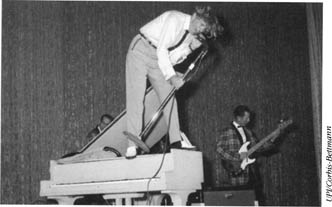
Jerry Lee Lewis finds a new use for a piano at his opening night at the Café de Paris, New York, 1958.
Known as “The Killer,” Jerry Lee Lewis was one of the most flamboyant, energetic, and self-assured performers of the rock’n’roll era. At his peak Lewis challenged Elvis Presley’s claim to be the “king of rock’n’roll.” Whoever wore the crown, Lewis’s manic performances, and alcohol and drug binges, certainly earned him a reputation as the most outrageous and rebellious rock’n’roller of his generation.
A piano player and vocalist, Lewis’s musical style, which he refers to as a “pumpin’ piano” style, was a blend of African-American boogie-woogie and white country honky tonk, with exuberant soloing, peppered with wide, fast glissandi, swiping up and down the keyboard His extremely expressive vocals cover a wide range of emotions, with nuances derived equally from country, gospel, and blues singing styles. In the 1990s, Lewis and his band—Roland Janes (guitar), Jimmy Van Eaton (drums), and J. W. Brown (electric bass)—played in a Memphis country rock style.
Born in Ferriday, Louisiana, in 1935, Lewis began his career at age 15 playing country piano in bars. Influenced by the piano blues he heard as a youngster behind an African-American honky tonk dance hall, Haney’s Big House, Lewis’s style is rooted in the boogie-woogie tradition of the southwest. At age 16, Lewis enrolled in the Southwestern Bible Institute in Waxahachie, Texas; he was expelled in his first semester when he played a boogie-woogie accompaniment to a hymn during the chapel service. Lewis returned to Ferriday and played in country honky tonks. In 1956, he auditioned at Sam Phillips’s Sun Studio in Memphis. Lewis recorded the country song “Crazy Arms,” released as his first single in December 1956. There Lewis also played piano on recording sessions for Carl Perkins and Billy Lee Riley, two of Phillips’s major acts.
Though Lewis was unknown nationally when “Whole Lotta Shakin’ Goin’ On” was first released, an enthusiastic reception following his debut on The Steve Allen Show in July 1957 drove the song into the Top 10 on the Billboard charts. It topped the country and rhythm-and-blues (R&B) charts, and reached No. 3 in the pop chart. The follow-up, “Great Balls of Fire,” reached No. 1 on the country chart, No. 2 in pop, and No. 3 in R&B. These two songs, and his wild stage act, gained Lewis a place in rock history. Other hits followed, notably “High School Confidential” and “Breathless.” But Lewis’s last songs for Sun were “What’d I Say” and “Cold, Cold Heart” in 1961, both of which barely broke the Top 40.

Jerry Lee Lewis finds a new use for a piano at his opening night at the Café de Paris, New York, 1958.
In 1958 a scandal surrounding his marriage to his 13-year-old second cousin, Myra Brown, damaged Lewis’s career. He made a comeback in the 1960s, establishing a successful career in country music. Between 1968 and 1973, Lewis had 12 Top 10 hits on the country charts. In the late 1970s, his voice and piano playing deteriorated due to drug abuse, and his career was affected by publicised confrontations with the law. He continued touring and recording, playing his country and rock’n’roll hits. Though performances in the 1980s exhibited a slightly reserved Jerry Lee Lewis, his 1995 album Young Blood showed a return to his old form.
Stephen Valdez
SEE ALSO:
BLUES; COUNTRY; GOSPEL; ROCK MUSIC; ROCK’N’ROLL.
FURTHER READING
Lewis, M., with M. Silver. Great Balls of Fire! (London: Mandarin, 1989);
Tosches, Nick. Hellfire: The Jerry Lee Lewis Story (New York: Dell Publishing, 1982).
SUGGESTED LISTENING
Great Balls of Fire; The Sun Years; Young Blood.